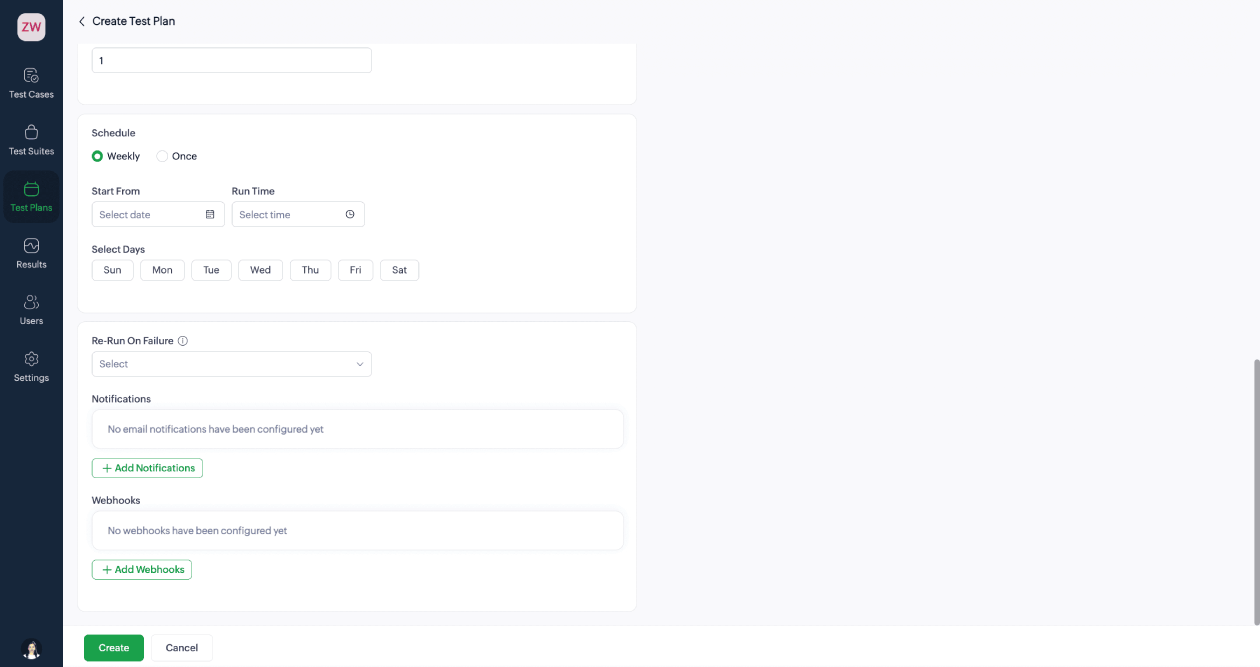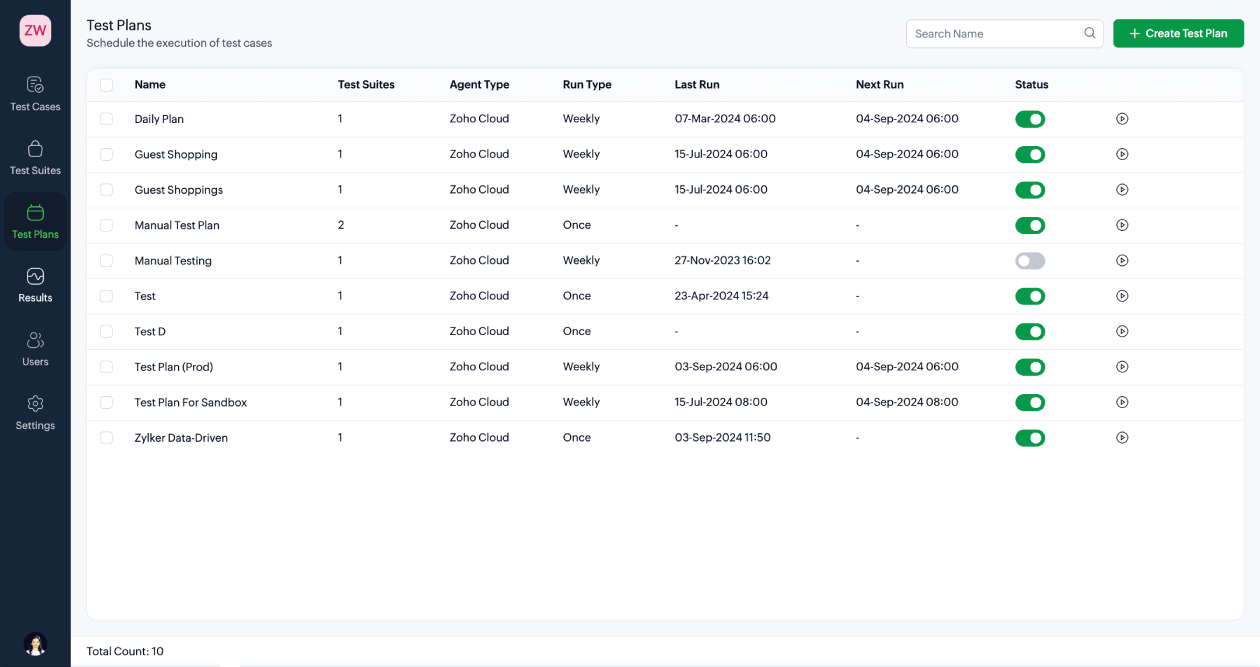Key takeaways
- Test plan: A test plan is a project-specific document that outlines project scope, objectives, roles, responsibilities, approach, resources, project schedule, and risk management for effective testing.
- Benefits of test plans: They provide clarity on the project, improve efficiency, mitigate potential risks early on, enhance collaboration, streamline resource allocation, and ensure structured testing.
- Test strategy: A test strategy is an organization-wide roadmap to standardize testing across various projects and align them with business objectives and compliance.
- Benefits of test strategy: Test strategies are key for decision making, promoting process refinement, reflecting the organization's priorities, and enabling optimal allocation of resources.
- Key differences: Although they sound similar, test plans are flexible and project-focused, whereas test strategy is a rigid, company-wide testing approach driven by management.
- Zoho QEngine advantage: QEngine offers easy test plan creation with features like test case management, execution, scheduling, and reporting.
What is a test plan?
A test plan is a crucial step, detailing how testing will be carried out in the software testing process. It outlines structured descriptions for testing activities and strategies for the testing team to evaluate quality software. A comprehensive test plan provides objectives, scope, roles and responsibilities, timelines, risks, and risk mitigation strategies. Test planning covers the types of testing, the features to be tested, tasks, personnel, resources, environment setup, and timelines to provide a clear understanding of the project and test deliverables for the testing team.
Components of a test plan
- Key components of a test plan include objectives, scope, approach, resources, schedule, and risk management.
- The scope of a test plan defines the extent and boundaries of the testing activities for the testing team.
- Resource planning is an integral aspect of the test plan document and identifies all the resources required for project completion, including human effort, hardware, and software.
- For every testing project, a test plan document should include potential risks and strategies for mitigating them.
- The test plan should set realistic goals for a project.
Benefits of a test plan
Clear objectives
A clear understanding of the objectives, goals, scope, timeline, and expected results of the project is provided to all the stakeholders.
Efficiency
A test plan improves efficiency by setting clear goals, allocating resources, prioritizing tasks, and assessing risks.
Resource allocation
Resource allocation varies depending on the criticality of a project. A project's test plan details the required human resources, tools, devices, and environments.
Risk assessment
Potential risks and issues that could impact the testing process are identified early on to mitigate them proactively.
Structure
A test plan provides detailed instructions on testing and streamlines the testing process by providing a structured approach to testing and documentation.
Collaboration
Setting clear objectives for all stakeholders and defining their role improves collaboration.
How to create an effective test plan
The first step to creating a test plan is to gather insights from key stakeholders such as QA managers, developers, business analysts, and domain experts. Let's take the example of an e-commerce platform.
An effective test plan should include the following steps.
The initial step is to analyze the platform's architecture, documentation, and specification to devise a customized plan is essential for test planning.
This helps create a test strategy document that defines the scope and objective.
Based on the test strategy document, the QA team outlines the test scenarios. For example:
- Business requirement: The search functionality must function as intended.
- Business logic: End-users must be able to search for products by name or category.
- Test objective: Verify the speed and accuracy of the search functionality.
Effective resource planning is the next crucial step and needs to detail the hardware, software, budget, etc.
The test deliverables must be defined based on the business requirements.
Based on the test deliverables, the estimated time to deliver can help with setting milestones. Documentation of test deliverables can be reused for future projects.
This can then be reviewed and finalized.
Zoho QEngine provides additional in-built tools for creating test plans, including test case management, test execution, and reporting. Click here to know more.
What is a test strategy?
A test strategy dictates the test process, given organizational quality requirements and compliance standards to ensure the testing process is as effective as possible. A testing strategy details the objective, approach, and types of testing to be conducted for multiple projects across the organization.
Components of a test strategy document
- Defining the scope and objectives in a test strategy document involves specifying the testing tasks, responsibilities, and timelines.
- The test strategy document establishes the techniques and approaches to be employed in the testing process.
- The test strategy document will contain the various types of testing that would be used across test projects, such as functional testing, performance testing, visual testing, security testing, and other relevant testing methodologies based on the project requirements.
- The test strategy document also defines the different testing methods to be used, such as unit testing, integration testing, end-to-end testing, and the like.
- Effective risk management in testing involves identifying potential issues early and implementing strategies to mitigate those risks.
Benefits of a test strategy
Business goals
A well-defined test strategy promotes test practice standardization across multiple projects and aligns them with the organization's business goals.
Key decision-making
The test deliverables are mentioned in the test strategy, providing stakeholders with insights into the testing process and help in key decision-making.
Optimization
A test strategy reflects the organization’s priorities and allocates resources accordingly.
Process refinement
Documenting the testing approach in the test strategy helps learn from past experiences to improve process efficacy.
Things to remember while developing a test strategy
- Incorporating industry norms and organizational standards into the testing strategy will help ensure compliance and alignment with business objectives.
- The test strategy should analyze project requirements to arrive at the best testing practice to ensure performance and scalability.
- The testing environment, compatibility with existing systems, and the skillset of testers should be taken into consideration while choosing the testing methodologies lined out in a test strategy.
- The test strategy must include specific test types.
- Testing strategies should pick appropriate testing tools that would support the test methods and help meet project requirements.
- A robust testing strategy should assess the risks associated with the testing process to come up with effective risk mitigation strategies.
Key differences between a test plan and test strategy
How to create a test plan on Zoho QEngine
The importance of a test plan lies in its ability to provide a structured framework for testing, helping QA managers avoid uncoordinated testing, facilitating efficient resource allocation, and ensuring systematic and organized software testing. Zoho QEngine has features such as test case management, test plan execution, scheduling, and reporting to help you create test plans with ease.
Here are the steps to create a test plan on Zoho QEngine
- Once you log in, navigate to the Test Plans module in the left pane.
- Click Create Test Plan.
- Give your test plan a name and define its scope and objectives in the description box.
- Select the environment, tunnel, and whether you want the test plan to be executed on the cloud or local agent.
- Select the test suites and schedule them by picking a start date, run time, and whether they should be run repetitively or just once.
- The customization settings help you with follow-up actions, such as re-running test cases on failure or sending notifications to stakeholders.
- The last step is to review the test plan and click Create.
Test plan scheduler

Test planning module
